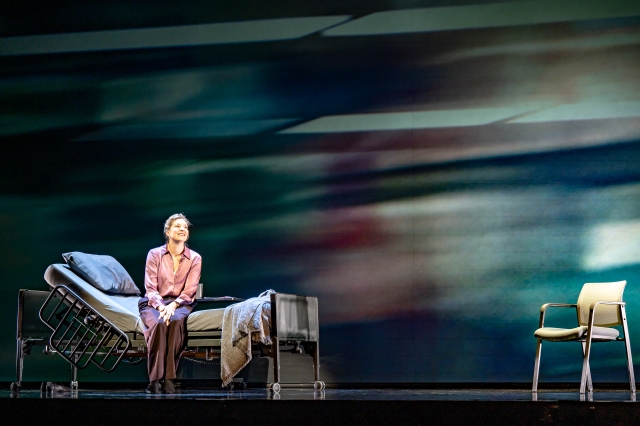Live and in person at the Coal Mine Theatre, Woodbine and Danforth, Toronto, Ont. Playing until Dec. 1, 2024.
Written by Samuel D. Hunter
Directed by Ted Dykstra
Set and lighting by Nick Blais
Costumes by Des’ree Gray
Sound and composer, Aaron Jensen
Cast: Mazin Elsadig
Noah Reid
A beautifully written play about male friendship and fierce love of their children, in a heart-squeezing production that is wonderfully acted and directed.
The Story. No, this isn’t an esoteric religious tract. One would think so with a title like that. But it’s not.
A Case for the Existence of God is a play about a friendship between two unlikely men, both doting single fathers who adore their very young daughters—the daughters are about 18 months old.
Ryan works in a yogurt factory. Keith is a mortgage broker. Ryan has come to Keith for a loan. Ryan wants to buy a plot of land that his family once owned. He plans to build a house there. He feels that if he has that land he can give his daughter a good life. He also says that if he had money, then it would justify his existence. Ryan is going through a divorce. He’s going through a hard time. He shares custody of his daughter with his wife.
Keith has given Ryan the loan papers and tries to explain them, but Ryan is struggling to understand the terms and language etc. Keith appears successful; he has a college education, a responsible job but also has his issues. He’s a Black gay man who has tried to adopt a child but has had difficulty. So, he put himself forward as a foster parent for this young toddler. He is responsible, dotting and attentive to his daughter. But he has learned recently that while the birth mother of the little girl is unfit to raise her, the mother’s aunt has come forward after almost two years to try and adopt the little girl herself. Needless to say, Keith is fretting about this, but doesn’t want reveal this to Ryan.
There is a tentative connection between the two men because they met in their daughters’ daycare. By rights, Ryan is not eligible for the loan—he has no collateral. But Keith feels a kinship with Ryan and so works hard to find any angle to get him the loan.
One of the most devastating lines of the play is when Ryan says that they have a shared sadness. It takes your breath away, because it’s true.
The Production. Nick Blais has designed a stylish office for Keith. There are two black swivel chairs with Keith’s being the more substantial with a high back. The black desk is narrow. There is one plant and around the border of the office are black boulders. Is this supposed to suggest a ‘man-cave’? And interesting thought.
Des’ree Gray has designed the costumes: a crisp shirt, tie and pants for Keith and worn t-shirt, pants and work boots for Ryan. Ryan also wears a baseball cap. The clothes accent their social/economic divide. The play unfolds after several office meetings between Ryan (Noah Reid) and Keith (Mazin Elsadig).
With just a change in the light (again, Nick Blais) the scene changes and we know that time has passed. The body movement of both characters snaps to a different position so we know the scene has changed. Noah Reid as Ryan might take his baseball cap off to suggest the change, or put the hat on backwards for the same reason. Mazin Elsadig as Keith shifts to another position in his chair all at the same time. Director Ted Dykstra has carefully choreographed these scene changes with economy. His direction is also so nuanced that it rivets you to the action.
We get the sense that the friendship is deepening when one of the scenes takes place at night Ryan at Keith’s house watching tv and having drinks. Ryan falls asleep in the chair and Keith calls out to Ryan asleep in the chair but Ryan is too deep in sleep to rouse. Keith nods off too.
But then there is the little cry of Keith’s daughter through the machine that is on the table that will pick up any noise in the baby’s room. And like a shot both men are startled awake. I loved that both men are so a tuned to the sound of a baby crying that it would rouse them out of the deepest sleep.
The acting between Noah Reid as Ryan and Mazin Elsadig as Keith is exquisite and detailed. Both listen to the other. Both react with truth. The characters listen so hard to each other than they can sense when something is wrong. A character might lash out, and it’s discovered that it’s mis-placed anger, and that makes a scene richer when one character is so attuned to another.
Playwright Samuel D. Hunter is so nuanced and subtle in his writing. He has created believable men. You get the sense of what it must have been like for Keith, this gay Black man to be a gay Black kid in his small-town high school in which he is aware of slights, both real and imagined. And he has carried that into adulthood. It doesn’t go away like magic with maturity.
And we get a sense of Ryan’s disappointment as an adult because he was a kind of popular star in high school, who never lived up to the promise. I think of the other disappointed guys of promise: Biff in Death of a Salesman, the Gentleman Caller in The Glass Menagerie all looking for validation. Ryan has always been dirt poor, lonely, perhaps unloved since his parents were addicts and his father died young. And yet both men see the good in the other. Both men bolster the other, even though it starts out uneven in power—one man wants a loan and the other has the power to get it for him. The friendship evens the relationship. And the bond over their daughters, the fierce love they have for their child, grips them.
I can’t remember the last time I saw a play about male bonding of two such strong but fragile characters. Sex never enters into it, not even in jock talk. And the fact that there is no hint of anything sexual makes the play remarkable. They don’t become lovers with Ryan all of a sudden realizing he’s gay. This is not a play about macho guys bonding trying to one up the other.
No. This is a play about a gay Black man and a straight white man who become true, deep friends. This is a play about two men going through rough times and supporting each other because of it. They are kind, they listen to each other, they see the good in the other—there are bumps along the way. But I was stunned at the sensitive, elegant writing that dug deep into the feelings. How rare is that, that we are dealing with caring men who take their care of their daughters and spread it to the friendship with each other?
Comment. As for the title, A Case for the Existence of God, it seems like a non-sequitur but on closer reflection I think the whole play is proof. There are also events that happen that I can’t reveal because that would give away some of the surprises, but various things happen that prove the title. Samuel D. Hunter is one gifted writer and A Case for the Existence of Godis one example why.
Coal Mine Theatre Presents:
Plays until Dec. 1, 2024.
Running time: 80 minutes (no intermission)
{ 0 comments }

